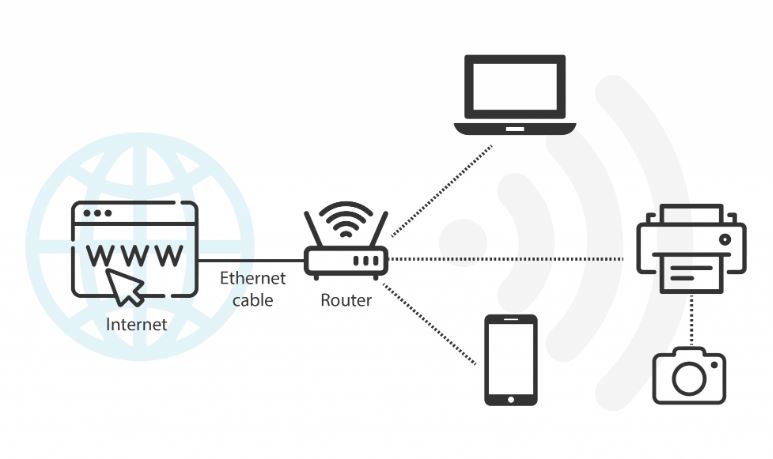WiFi is probably something the world can never live without. Some technology facts have shown that there are 3.8 billion Internet users and approximately 8 billion gadgets are being connected to the Internet each day. It is undeniable that WiFi is and will continue to be ubiquitous in our lives. We can even personalize our own WiFi nowadays. But, the invention of WiFi and how it works are equally important to know as well.
One can say that the invention of WiFi was a team effort by different people and with a stroke of luck.
The first group of people involved was Australian radio astronomer John O’Sullivan and a group of scientists. Back in the 1900s, they wanted to prove that Stephen Hawking’s theory on evaporating black holes and their radio waves are true. Their research showed that these little waves and their subsequent signals could travel over large distances. But it was difficult to differentiate these little waves from stronger ones. Thus, Sullivan and the researchers worked on creating a tool that could help identify the black hole’s radio waves. Unfortunately, they failed.
The next notable person, also known as the “father of WiFi”, is Vic Hayes. He was one of the founders of the 802.11 standards, a set of standards that ensures wireless communication work in reality. Before the public even understand the concept of wireless communication, Hayes was already thinking of ways to make WiFi standards achievable. But, he needed a patent. And as you can guess, this key patent came from Sullivan and his failed tool. In 1992, John Sullivan, Terence Percival, Graham Daniels, Diethelem Ostry, John Deane who were working in the company, CSIRO, went back to Sullivan’s failed experiment and eventually created a chip that could pick up the weakest radio signals. Poof! WiFi was invented in 1997! Guess we can say the invention of WiFi is unexpected but greatly appreciated.
What is WiFi?
Did you know that WiFi is just a meaningless acronym? Some may say that WiFi stands for Wireless Fidelity. But Phil Belanger, one of the founding members of WiFi Alliance (which owns the WiFi logo), dismissed this. He stated that WiFi is simply an acronym with no meaning. Although WiFi began in 1997, it was not known as ‘WiFi’ until 1999.
How does WiFi work?
WiFi is essentially a superb networking technology. It uses a radio frequency signal (the WiFi logo on your gadgets) to send information. This information then helps to connect smart gadgets like smartphones, laptops and many others together that are within a local area, like your home. When a connection is made, communication between these gadgets can happen. Picture a radio tuning into a radio station by picking up signals. Similarly, your devices can pick up such high-frequency signals to connect to the Internet. And those high-frequency signals are WiFi! WiFi runs on two main frequencies: 2.4GHz and 5GHz bands. 2.4GHz bands cover a wider distance and WiFi can be picked up through thicker walls. 5GHz bands have a faster connection speed over smaller distances. But it generally experiences more interference.
WiFi does not magically appear out of thin air. Which is why you need a wireless router for your gadgets to connect to the Internet. A wireless router is a piece of equipment that physically connects to the Internet via an ethernet cable or modem. The router broadcasts the WiFi signal that connects and carries information to and fro from the Internet. While carrying this information, your router is hard at work decoding this information. The adapter in whatever device you are using then picks up this broadcasted signal, receives the decoded information, and sends it back to your router so that it goes onto the Internet. Essentially, your router is like a middleman, or a dispatcher between your devices and the Internet.
Is WiFi The Same As The Internet?
This also means that WiFi is NOT the same as the Internet. We often conflate these two terms together but really, they are two very different and separate things. WiFi is the frequency signal that allows us to connect to the Internet. The Internet, also known as Wide Area Network (WAN), is a massive network of networks. It connects various local networks together via many routers and forms a global connection.
How has WiFi changed over the years?
WiFi became very popular in the early 2000s and ever since, many have worked on bringing more exciting enhancements to the original standards. One can say that the invention of WiFi is a miraculous event that has helped us push past unthinkable technological boundaries and frontiers.
Getting Faster
The original 802.11 started out with 2 Mbit/s (megabyte per second) link speed, and over the years it has grown faster to 11 Mbit/s (802.11b, 1999), 54 Mbit/s (802.11a, 2012), all the way to 568.9 Mbit/s in the 2014 version. As of 2020, WiFi 6 (802.11ax) runs on 9.6 Gbps. Currently, cities in these countries have the fastest Internet connection.
Growing Stronger
WiFi also became stronger throughout the years. Initially, WiFi routers used the 2.4GHz band in 1999, before the 5GHz band was introduced in 2012. In 2003, the 802.11g standards were developed to improve both connectivity speed and signal range. Router technologies also began to enhance to have higher power and coverage than its predecessors. One notable router technology is the introduction of dual-band routers to help solve the issue of slow connectivity speed, out-of-range and interference issues. Devices in range would automatically connect to the more efficient 5GHz frequency. Even if devices are further away or behind walls/doors, our WiFi routers can use the 2.4GHz band to actively maintain connectivity.
Becoming Smarter — 2012 and beyond
In 2012, we welcomed a new era of WiFi. In the past, the various 802.11 versions focused on signal coverage and large data transmission. However, in 2012, a new concept called the beamforming concept is developed. Instead of focusing on broadcasting WiFi signals in all directions hoping to reach the targeted devices, it focuses on concentrating the signal towards a specific device. This ensures a faster and more stable connection. Currently, many of us use WiFi routers that use this beamforming concept.


